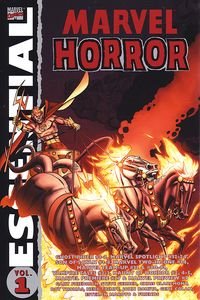Anyway, this con was one of the best San Diego Comic-Cons I've been to -- and I've been to 22 of them in the last 28 years. This despite the capacity crowd (it sold out before the first day of the con) and some unseasonable grey weather.
Thursday morning began with a blast of humor as I attended the Tiny Toons/Freakazoid panel. Along with Warner Brothers Animation stalwarts Bruce Timm, Paul Dini, Andrea Romano and MC Paul Rugg (the voice of Freakazoid), the panel featured my old friend John P. McCann, who was a writer/producer/voice actor on Freakazoid back in the mid-nineties. (John was one of two TV writer-producers at our wedding 11 years ago. I'll talk about the other one shortly.)
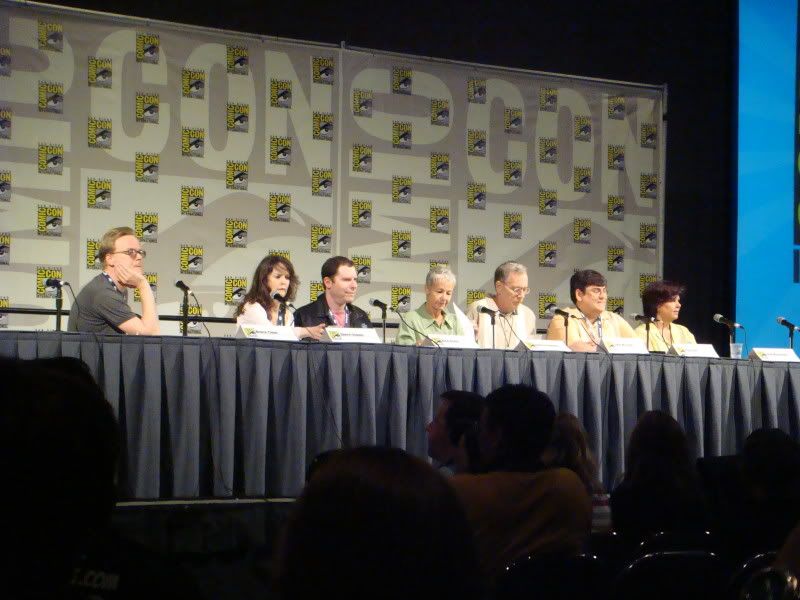
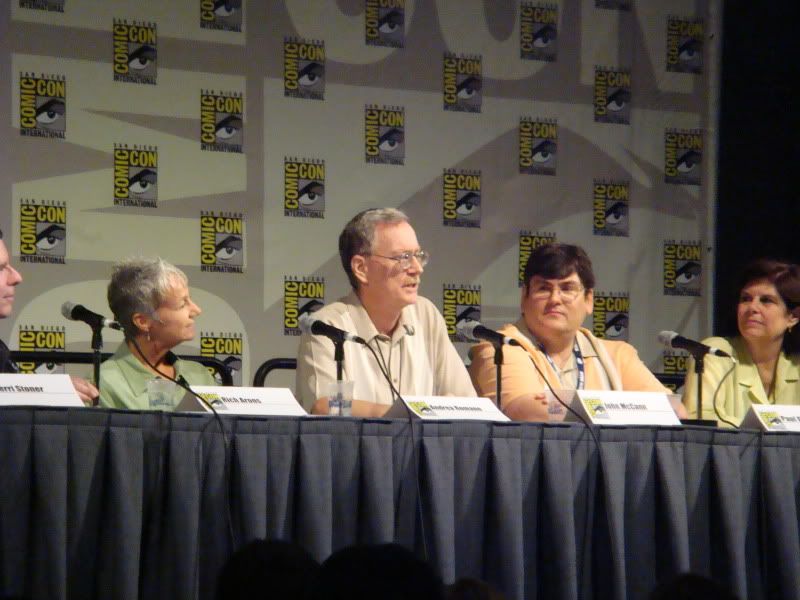
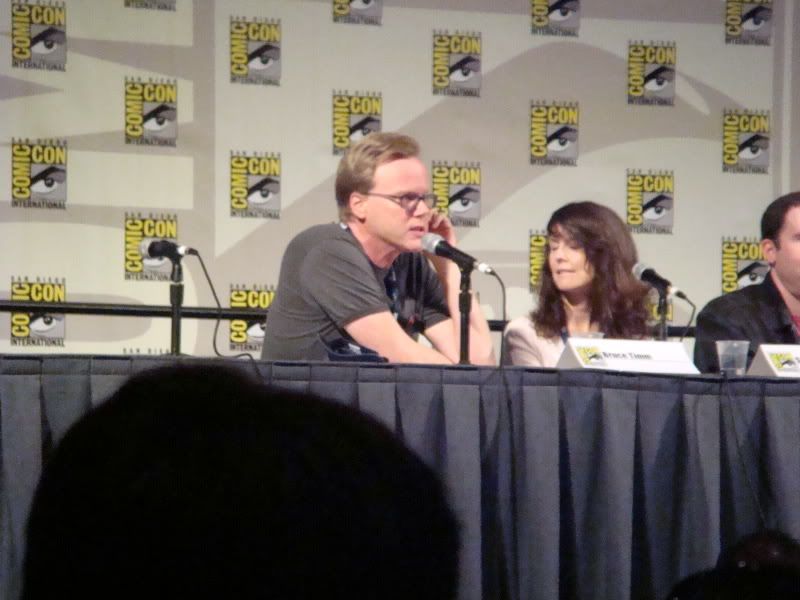
I didn't get a chance to talke to John, but we did get to catch up with his wife Joy, aka Miss Attila (see the link to her blog on the right margin).
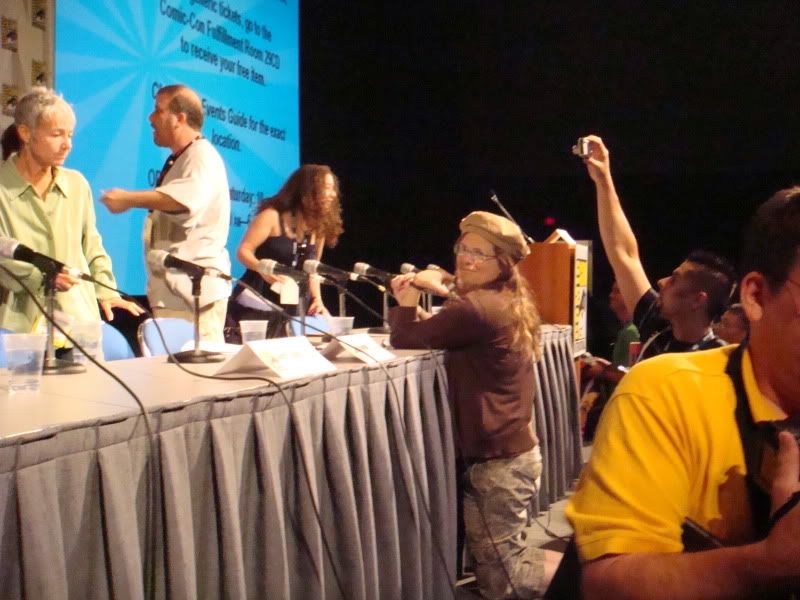
I attended a spotlight on one of the guests of honor, photorealistic comics penciller Paul Gulacy; and found out that he could do a terrific Sinatra impersonation. Gulacy revealed that when he was drawing "Master of Kung-Fu" back in the pre-VCR days, he would attend martial-arts movies in grindhouse theatres, toting an audio tape recorder with him. After the flick, when he sat at his drawing board, he would play back his tapes of the fight scenes; and when he heard the kyaas and grunts and impacts, he could play the fights back in his mind and draw them.
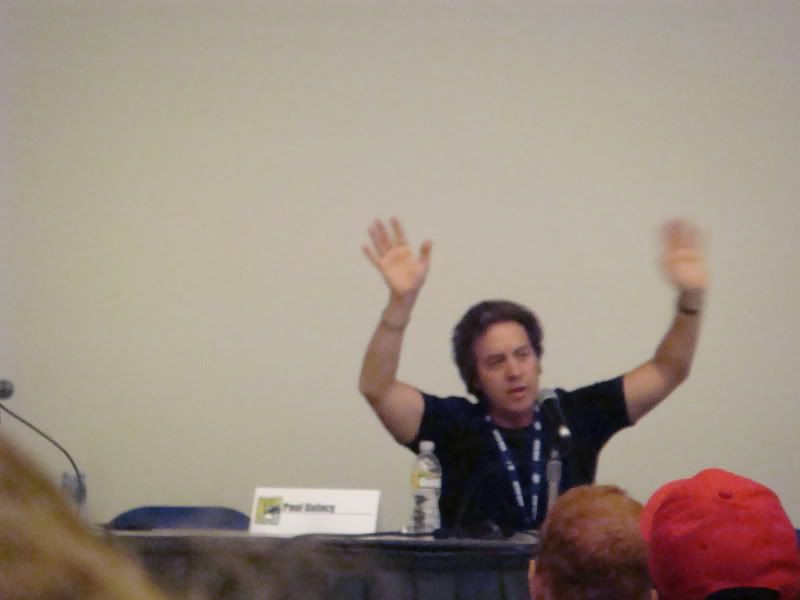
Later that afternoon, we went to a panel on the upcoming RED SONJA movie. Red Sonja is a character with an odd provenance: Seventies Conan the Barbarian comics writer Roy Thomas based her on a character Conan creator Robert E. Howard had wrote in a non-Conan story, but inserted her into the Conan universe. She was fairly popular when she appeared in a two-part Conan story, but her popularity exploded in the mid-seventies when her fairly practical battle outfit (a mail shirt and leather hot pants) was transformed into the most impractical suit of armor in history: a scale-mail bikini that left most of her body exposed. In the eighties, the producers of the Conan movie made a highly forgettable RS movie with Brigette Nielson, minus the bikini. Later, when Marvel lost the license for Conan, it also lost the license for Sonja -- a character created for Marvel. Currently, Dark Horse has the license for Conan and Dynamite has the comics license for Sonja. Now, Robert Rodrieguez (of SPY KIDS, DESPERADO, and SIN CITY fame) is planning a new Sonja movie, inspired by the issues of SAVAGE SWORD OF CONAN he used to read as a kid. Rodrieguez won't direct it; his assistant director on several projects, Doug Aarniokoski, will (because he's DGA and Rodrieguez quit that organization), with lots of collaboration by Rodrieguez. The actress chosen as Sonja, Rose McGowan (whom GRINDHOUSE viewers will remember as the lady with the machine gun on her stump), appeared on the panel with Rodrieguez. And the poster art they flashed showed that, yes, she would be wearing the bikini (although it's more of a tankini now).
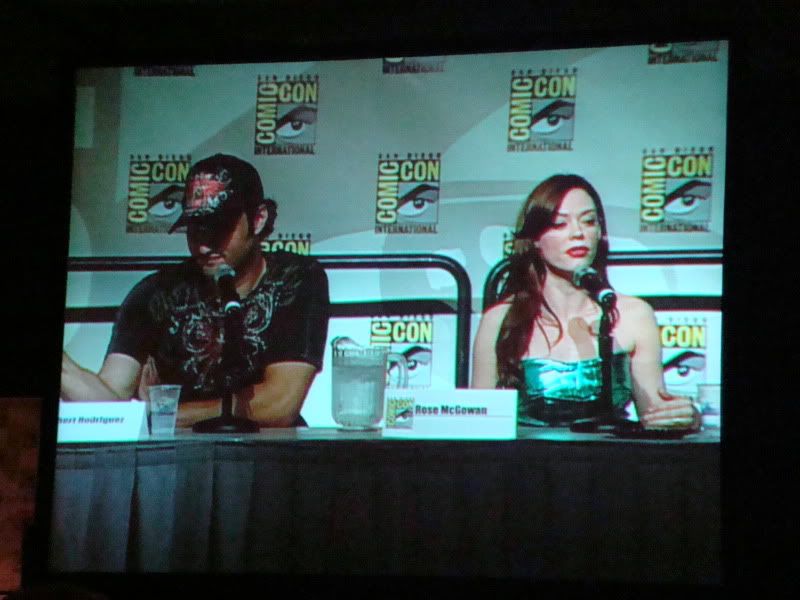
We attended a panel put together by Entertainment Weekly featuring Jim Lee, Grant Morrison, Colleen Doran, John Cassaday, and Mike Mignola (fortunately, the room did not ignite from sheer talent); and finished off the day by visiting our comics writer friend who was holding court in the lobby lounge of a nearby hotel. He snapped this picture of us:

We started Friday out with the panel for BATMAN: BRAVE AND THE BOLD, the latest animated incarnation of the Caped Crusader. (I'm too tired to count all the animated series that have featured the Darknight Detective.) This one avoids the dark, brooding version of our hero; the producers rightly opine that the Bruce Timm-Alan Burnett series from the nineties did the dark animated Batman about as well as it can be done. Instead, this series takes the more cartoony version of Batman drawn by 40's to '60's artist Dick Sprang, and tries to do a lighter-hearted Batman that is still action-packed and not a total goofball. The footage shown looked great.
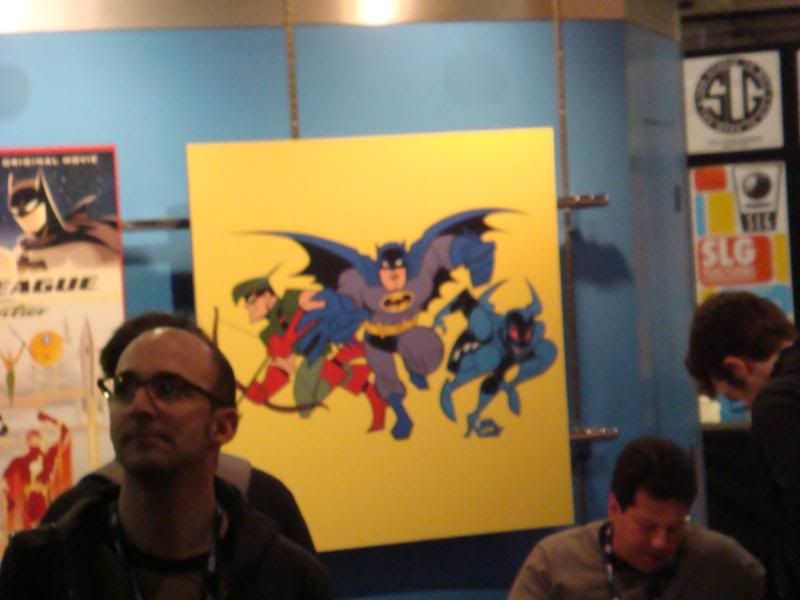
I somehow managed to get into Hall H for one of the most anticipated movie-project presentations of the con: WATCHMAN. (Amy wasn't able to join me; the 6,500 seat hall quickly filled to capacity.) 300 director Zack Snyder and artist Dave Gibbons introduced essentially the entire cast of Watchmen, most of them relative unknowns except for Billy Crudup (who was so good in ALMOST FAMOUS) as godlike naked blue guy Dr. Manhattan; and Carla Gugino (the mom from SPY KIDS, KAREN SISCO, and the topless parole officer from SIN CITY) as Sally Jupiter, the superhero stage mom with a dark secret. The cast was tremendously enthusiastic, and the footage shown truly looked ripped from the graphic novel.
Here's Dave Gibbons on the panel:

Here's Crudup:
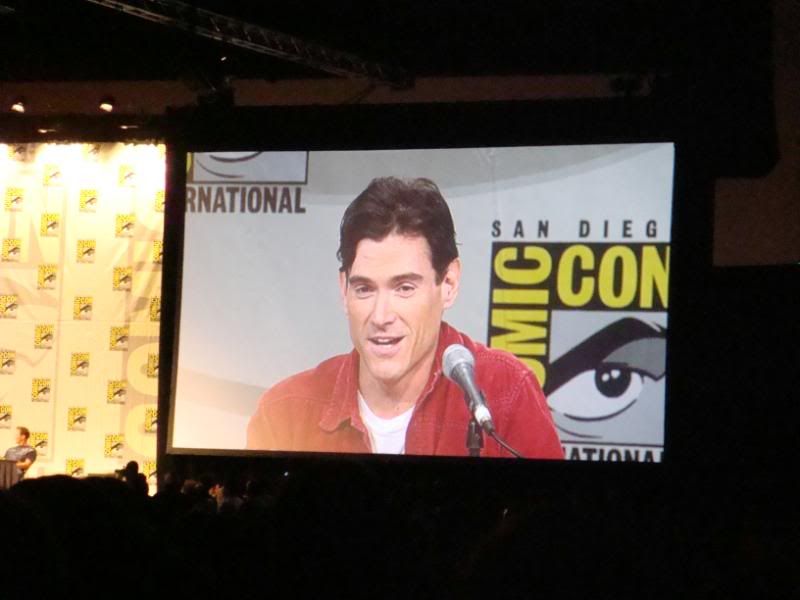
And some other cast members.

That afternoon, I attended the Scribe Awards/Media Tie-in Writer's Panel, primarily because my cousin Lee Goldberg (who co-founded the tie-in writer's organization that gave out the awards) was on the panel. When I got to the panel, Lee was waiting outside with his cute daughter Maddie. He shared the panel with co-found Max Allen Collins, STAR WARS/DUNE author Kevin J. Anderson (who handed out gummy sandworms as a promo for his latest DUNE book), and veteran SF/tie-in writer Alan Dean Foster. Everybody took turns telling Foster how much they loved his STAR TREK LOG novelizations of the STAR TREK animated series in the seventies. (I loved them too.) Lee won an award for his Monk novel MR. MONK AND THE TWO ASSISTANTS (which the moderator mispronounced, twice, as MR. MONK AND THE TWO ASSASSINS).
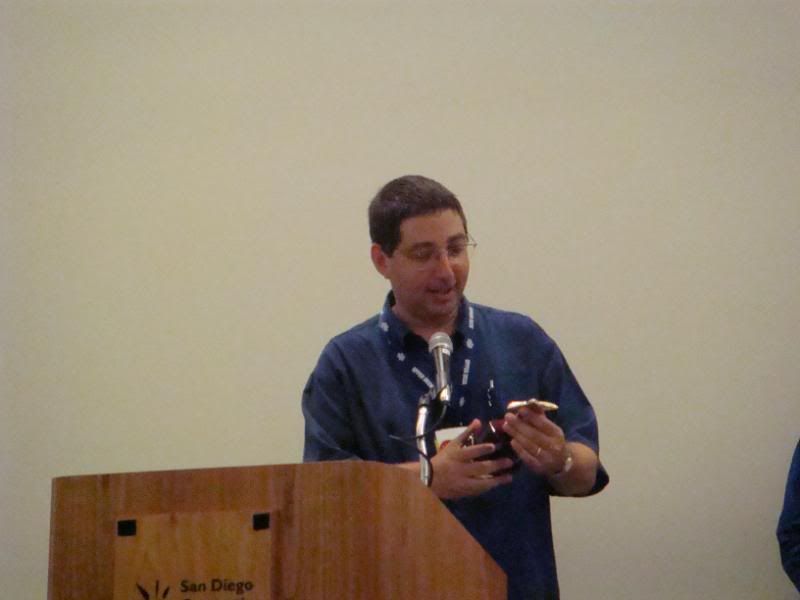
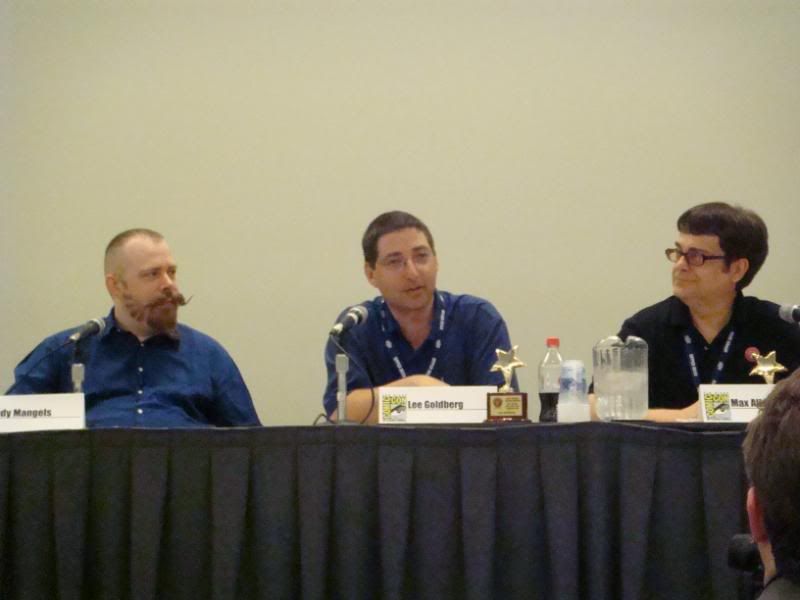
Yes, Lee was the other TV writer/producer at our wedding. (And Maddie was there too, although she doesn't remember it now . . . )
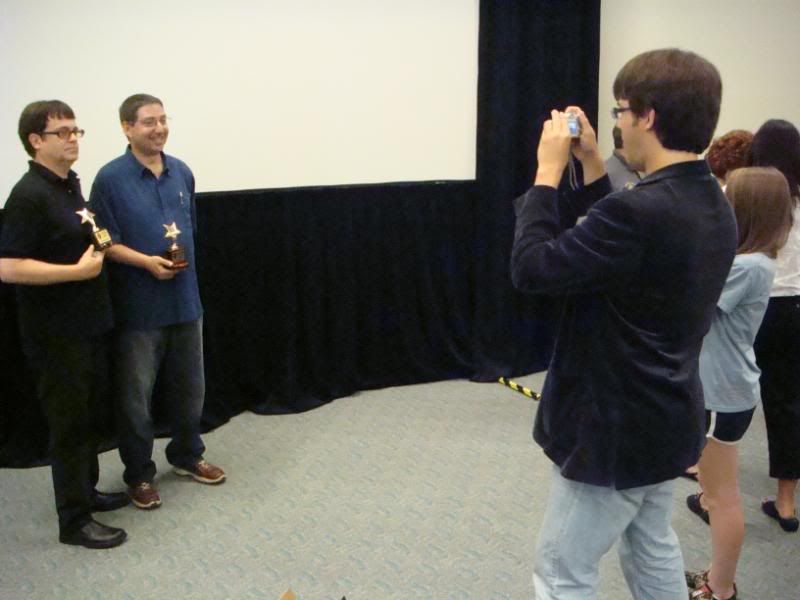
Amy put on a costume and took part in a HELLSING costume photoshoot:
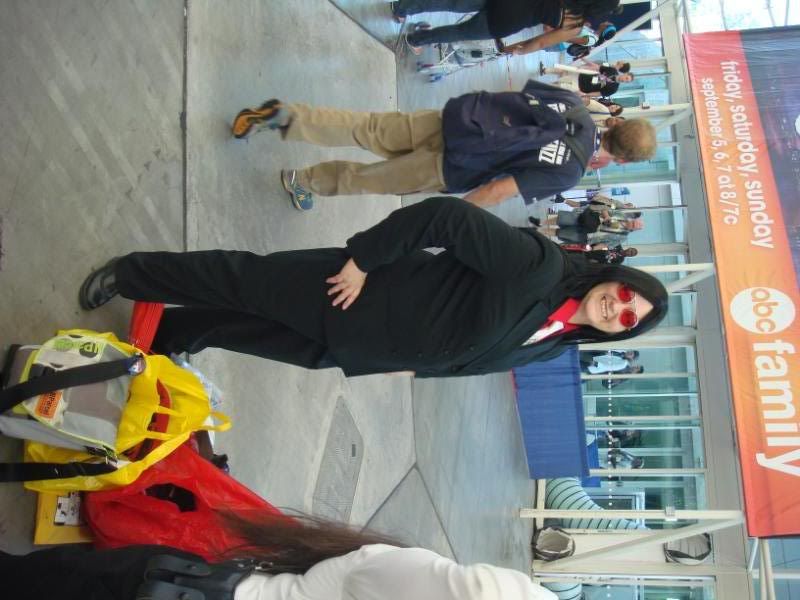
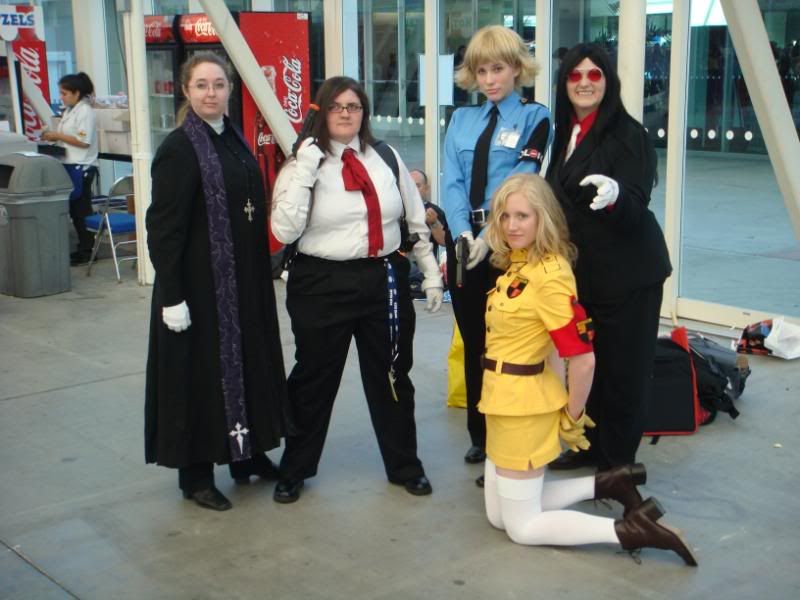
Then we hied ourselves to a local theater where Viz was screening the first BLEACH movie, BLEACH: MEMORIES OF NOBODY. The film was important to us for two reasons: First, when we were in Japan last year, the DVD of the film was just coming out; and we loved the Japanese announcer for the TV commercials who intoned -- with that odd cadence of one delivering lines in a foreign language -- the English words "Bleach! Memories of Nobody!" Second, the creator of the Bleach manga, Tite Kubo, attended the screening, as did several winners of an essay contest given by Weekly Shonen Jump, the mag that publishes BLEACH in Japan. As was explained at the screening, this was Kubo's first appearance in North America; and it was rare for creators of weekly manga features to venture abroad, because they have to produce a mind-boggling 19 pages of story and art EVERY WEEK. (Kubo's been doing that for seven years!) But the magazine allowed him to get ahead on the feature so that he could make this trip. The movie itself was fun, if primarily an excuse to allow each of the supporting characters in the strip to appear and show off his or her power.
Saturday began with an extra special treat: I was one of twenty winners of an online contest to actually meet Kubo, and get his autograph on a specially-prepared Bleach Shikishi (autograph board). Despite some logistical problems, I managed to get my autograph; and wished the smiling, Rayban-wearing, red-hair-dyed Kubo-sensei (in Japanese)a good time in America -- to which he responded, in English, "Thank you very much."

Amazingly, I then managed to get into another panel I had been looking forward to: one concerning the new comics anthology COMIC BOOK TATTOO, featuring stories inspired by the lyrics of Tori Amos. Ms. Amos herself was front and center in the panel, and was both articulate and entertaining, particularly when delivering imitations of her exasperated conversations with her English-accented daughter.
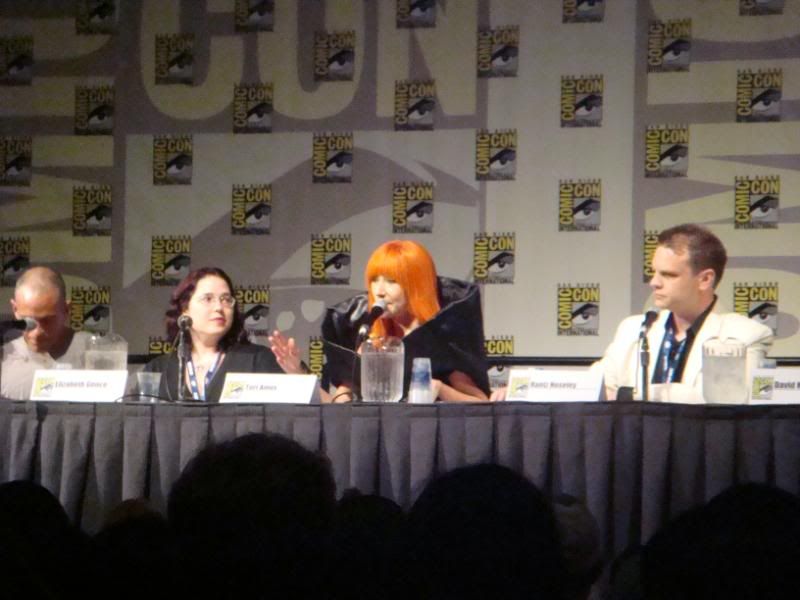
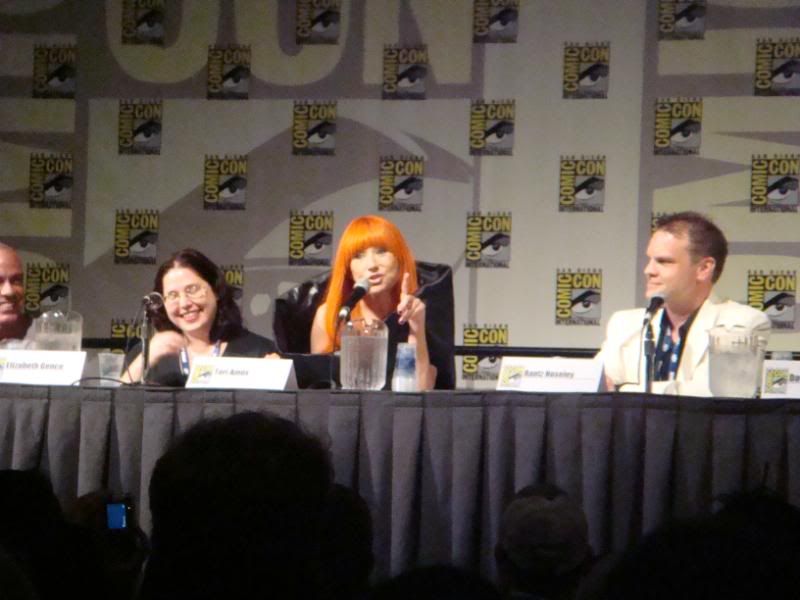
Getting into the Tori panel was particularly surprising because although I had secured seats in the room before the panel (by slipping into the Ralph Bakshi panel while Bakshi was waxing political -- "If you don't vote for Obama, you're crazy!"), I left it when I received a phone call on my cell from Seattle-based comic book writer/artist Mike Grell. Grell was doing sketches by commission at the con, and would take the cell phone number of the, er, commissioners. Thus summoned, I met him at his table at Artist's Alley, and picked up a beautiful sketch of Saturn Girl of the Legion of Superheroes (which Grell drew in the mid-seventies). I then fought my way upstream through the attendees who inevitably throng the dealer's room on Saturday; and still managed to score a seat fairly close to the front of the room.
(Interestingly, although publications such as the L.A. Times have bemoaned that the interest in comics programming at the con has been eclipsed by the movie blitzing, I noted that some of the hardest panels to get into were those aimed squarely at comics fans. I tried to get into some of Mark Evanier's comics history panels after they started, only to be confronted with a sign on the door of Room 8 announcing the room was at capacity.)
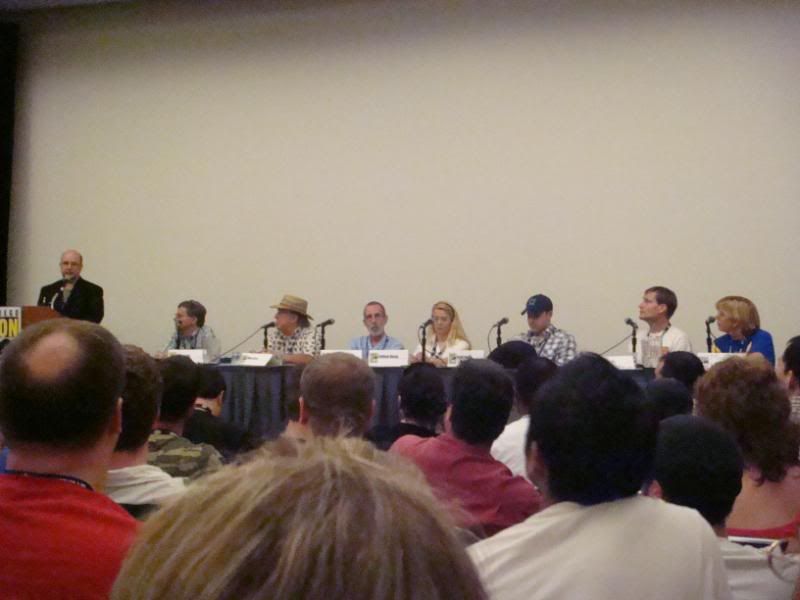
One of the best panels on Saturday was the one celebrating the 50th anniversary of the Legion of Superheroes, the ever-expanding band of future teen superfolk that has maintained a loyal fan following for decades. The panel included Paul Levitz (who wrote the Legion in the Seventies and Eighties, and is now president of DC Comics), Keith Giffen (who drew and plotted the Legion in the eighties), Mike Grell (discussed above), Tom and Mary Bierbaum (the married couple of Legion fans who wrote the comic in the late eighties), Geoff Johns (currently writing a Legion miniseries), and Colleen Doran (Legion fan and, often, artist). It's a joy to be in a room where everyone's so enthusiastic about the subject material.
Saturday ended with the Comic-Con masquerade, to which our friends Natalie and Sarah (who were in the masquerade) got us VIP tickets. (Unfortunately, the fellow "VIPs" behind us apparently took their status as license to talk non-stop.)
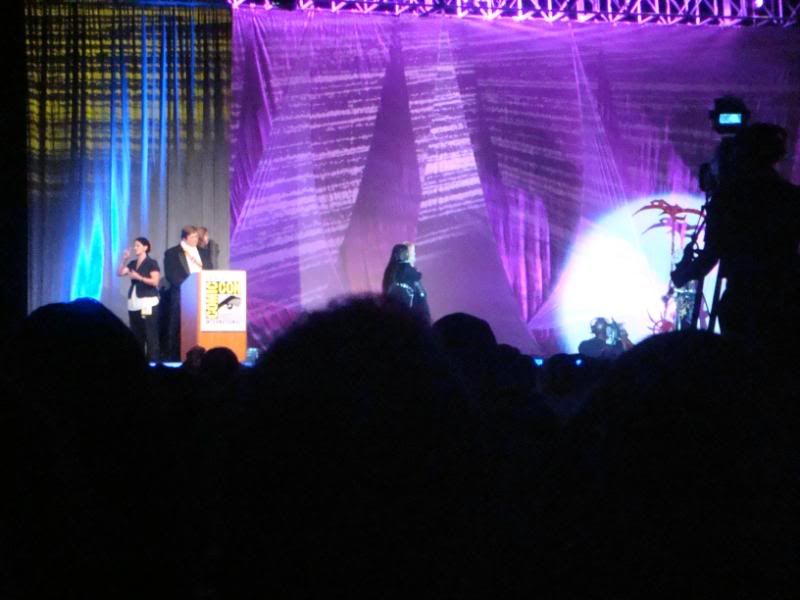
Here's some photos of our friends on stage:
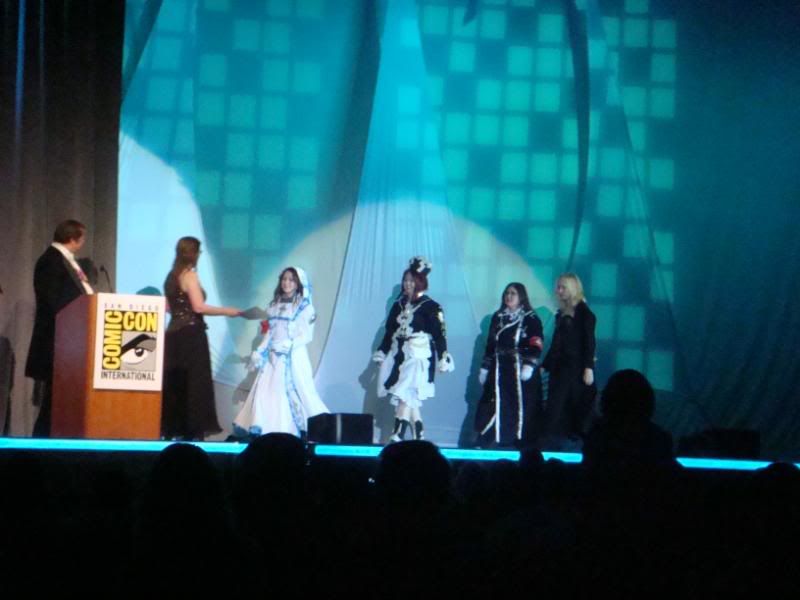
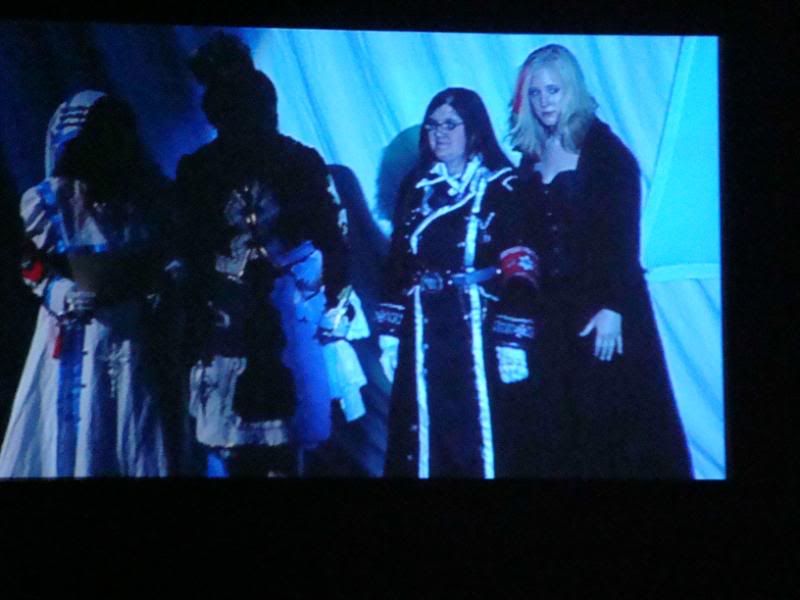
On Sunday, we packed up our toys; had breakfast at Cafe Noir, down the street from our hotel, and hit the con for the last time. We attended a panel about the goth icon Emily the Strange (a merchandising juggernaut, with stores in Hong Kong and Tokyo),
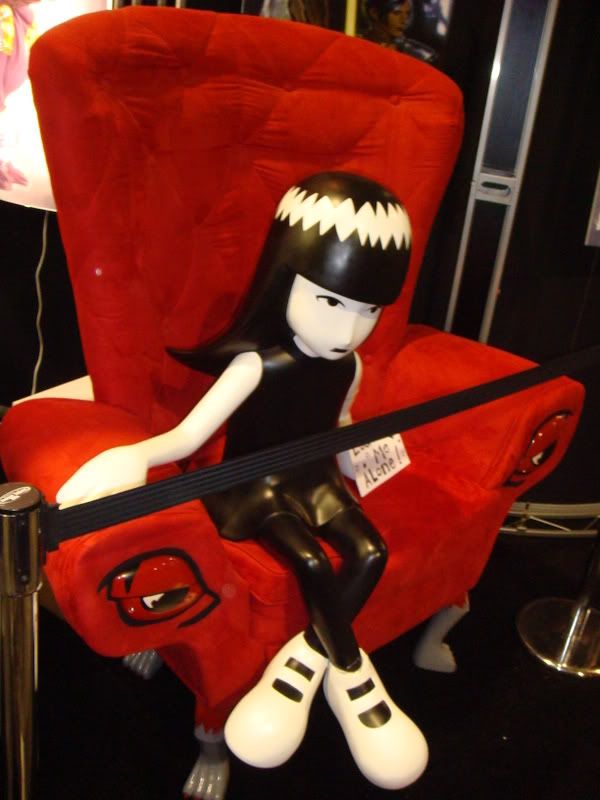
one about Elfquest, the long-running (30 years) comics series which has been optioned by Warner Brothers for a film (the director was on the panel),
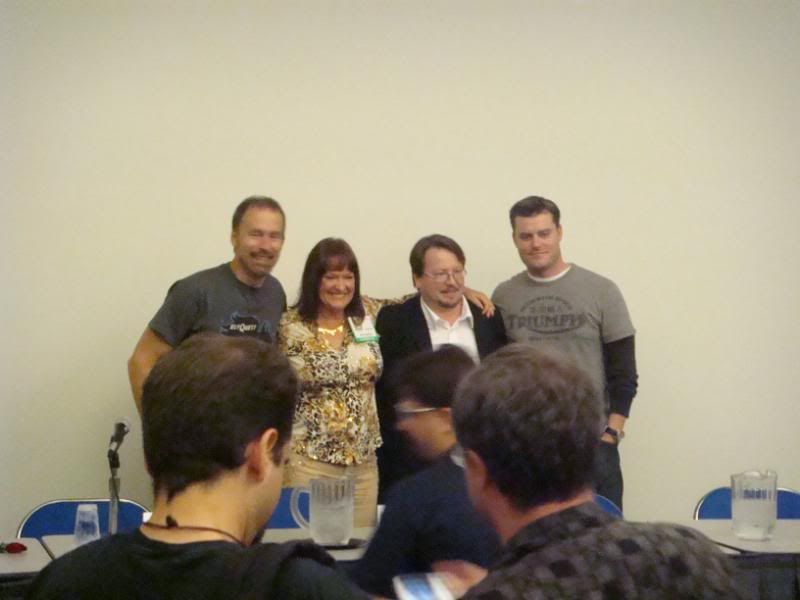
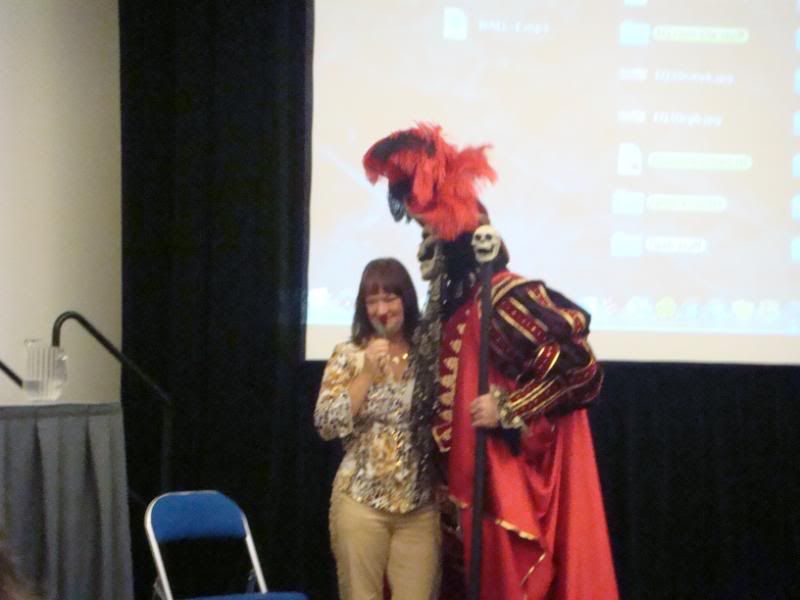
another on The Art of the Cover (moderated by Evanier -- the last of the 17 panels he MC'd);

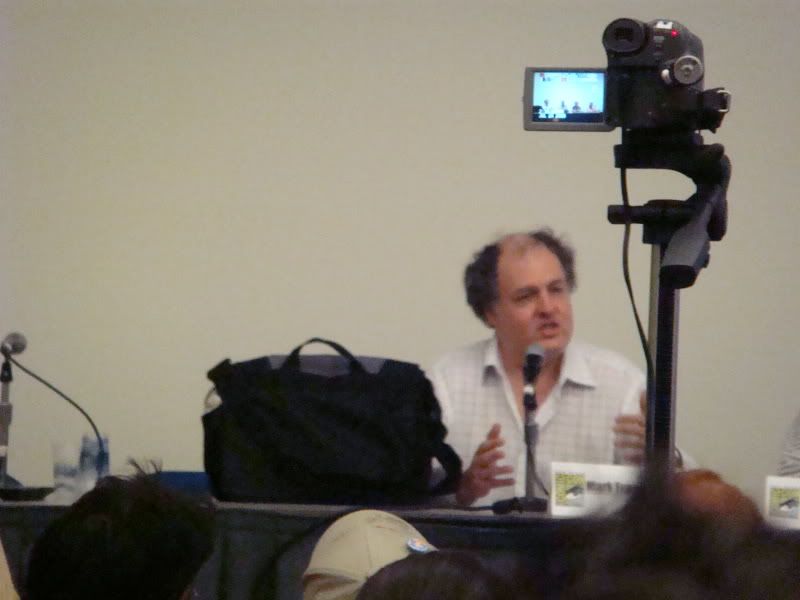
and a last strike at the Dealer's Room before we said goodby to the con. (And the Con said goodbye to us . . . .)
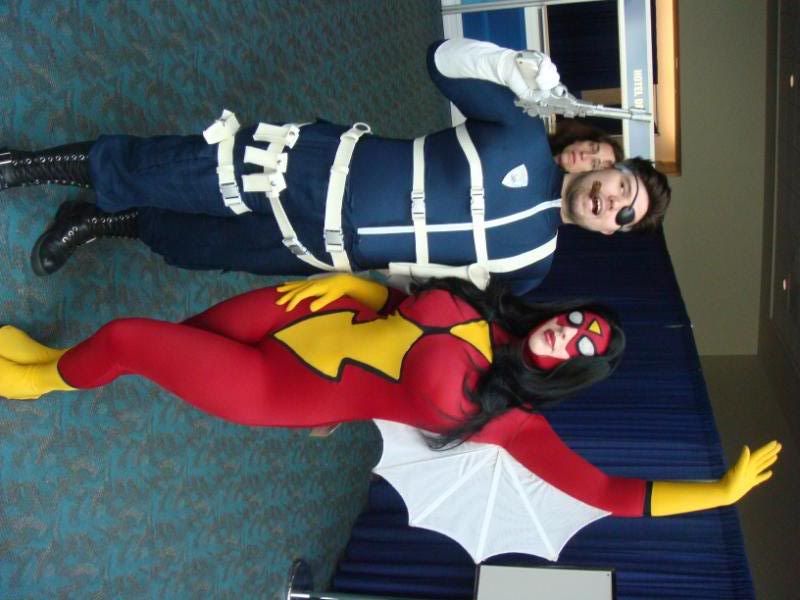
Our last comics event of the evening was the movie we watched while waiting for the traffic to die down: HELLBOY II: THE GOLDEN ARMY. It was a fun and visually beautiful movie, even if the paper-thin plot depended on supposedly brilliant characters doing really stupid things. (Mild spoiler: I am sick of fantasy movies in which the characters spend most of the movie trying to keep the magical macguffin the bad guy needs to take over/rule/destroy the world away from him; and then deliberately deliver said macguffin directly to the bad guy. Whatever happened to outwitting your opponent?)
That was it for another Comic-Con. Hope the next one is as good or better.









